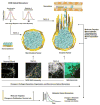Shining new light on 3D cell motility and the metastatic process
- PMID: 19819146
- PMCID: PMC2783928
- DOI: 10.1016/j.tcb.2009.08.009
Shining new light on 3D cell motility and the metastatic process
Abstract
Understanding tissue architecture and physical and chemical reciprocity between cells and their microenvironment provides vital insights into key events in cancer metastasis, such as cell migration through three-dimensional (3D) extracellular matrices. Yet, many mechanistic details associated with metastasis remain elusive due to the difficulty of studying cancer cells in relevant 3D microenvironments. Recently, optical imaging has facilitated the direct observation of single cells as they undertake fundamental steps in the metastatic processes. Optical imaging is also providing novel 'optical biomarkers' with diagnostic potential that are linked to cell-motility pathways associated with metastasis, and these can to help guide new approaches to cancer diagnosis and therapy. Here we present recent advances in one subclass of optical imaging of particular promise for cellular imaging - multiphoton microscopy - that can be used to improve the detection of malignant cells as well as advance our understanding of the cell biology of cancer metastasis.
Conflict of interest statement
The authors declare no conflict of interest.
Figures


References
-
- Sahai E. Illuminating the metastatic process. Nat Rev Cancer. 2007;7 (10):737–749. - PubMed
-
- Gupta GP, Massague J. Cancer metastasis: building a framework. Cell. 2006;127 (4):679–695. - PubMed
-
- Massoud TF, Gambhir SS. Molecular imaging in living subjects: seeing fundamental biological processes in a new light. Genes Dev. 2003;17 (5):545–580. - PubMed
-
- Weissleder R. Scaling down imaging: molecular mapping of cancer in mice. Nat Rev Cancer. 2002;2 (1):11–18. - PubMed
-
- Gambhir SS. Molecular imaging of cancer with positron emission tomography. Nat Rev Cancer. 2002;2 (9):683–693. - PubMed
Publication types
MeSH terms
Substances
Grants and funding
LinkOut - more resources
Full Text Sources
Other Literature Sources

